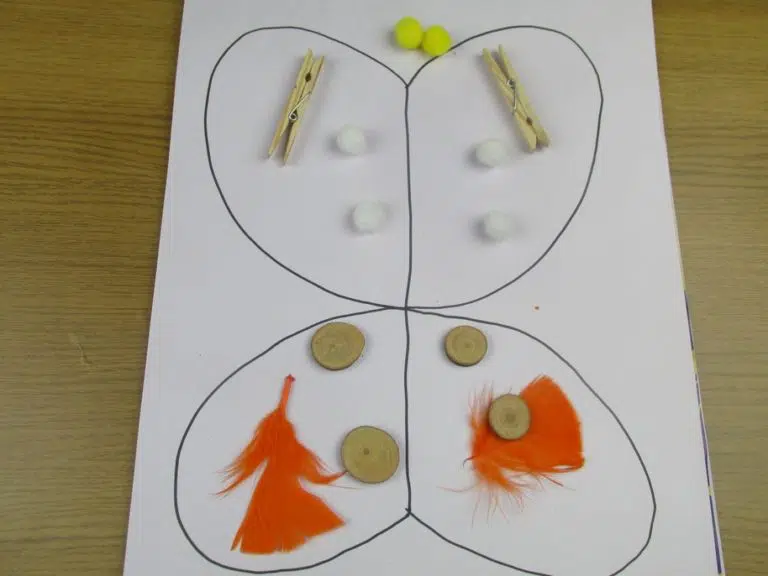Large paper or black chalkboard boards
Chalk for drawing outlines
Tinker trays filled with assorted loose parts (e.g., corks, bottle tops, feathers, pompoms, wood slices, leaves, bolts, pebbles)
Additional materials (e.g., colored paper, markers)
Introduction:
Explain the concept of symmetry and how it appears in butterflies.
Show pictures of real butterflies and discuss how both wings are mirror images of each other.
Setting Up:
Draw a large outline of a butterfly on paper or a chalkboard, ensuring a central line or body is clearly marked.
Arrange tinker trays with assorted loose parts nearby for easy access.
Creating the Butterfly Pattern:
Demonstrate how to create a pattern on one side of the butterfly using loose parts.
Encourage children to create their own patterns on one side of the butterfly outline.
Copying the Pattern:
Have another child or the same child copy the pattern on the other side of the butterfly, ensuring it is symmetrical.
Guide and support as needed, emphasizing the importance of making both sides identical.
Discussion and Reflection:
Ask the children to share their butterfly creations with the group and describe how they ensured symmetry in their designs.
Discuss how symmetry is found in nature, particularly in butterflies.
Gallery Walk:
Arrange the butterflies in a display area and have the children do a gallery walk to observe each other’s creations.
Encourage them to identify symmetrical elements in the butterflies they see.
Difficulty Levels:
Preschool to Kindergarten: Focus on simple patterns with fewer loose parts. Provide more guidance and support.
Grade 1: Introduce more complex patterns with additional loose parts. Encourage independent creation and problem-solving.
Grade 2: Challenge children to create intricate and detailed symmetrical patterns. Foster creativity and exploration of advanced symmetrical designs.
What Happened?
Children created symmetrical butterfly patterns, developing an understanding of symmetry through hands-on activities.
They practiced fine motor skills, spatial awareness, and problem-solving by designing and copying elements.
The activity provided a creative and engaging way to explore geometric concepts.
Explore More:
Create symmetrical drawings or paintings using paint and paper.
Use mirrors to explore symmetry in real-world objects and nature.
Incorporate symmetry into other subjects, such as making symmetrical patterns in music or dance.
Extension Activities:
Create symmetrical drawings or paintings using paint and paper.
Use mirrors to explore symmetry in real-world objects and nature.
Incorporate symmetry into other subjects, such as making symmetrical patterns in music or dance.

